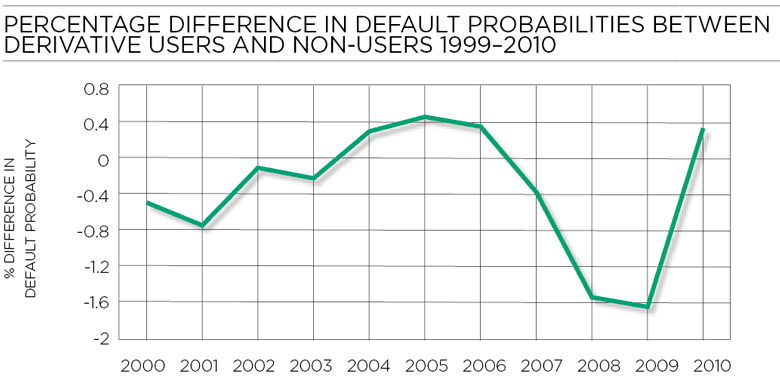
The question of whether firms are using derivatives for hedging or speculation is important in context of attempts by regulators to curb the use of OTC derivatives as a response to the 2008 financial crisis. It is also significant in terms of concerns about systemic risk in the financial sector and, more recently, the prospect of the introduction of the financial transactions tax (FTT).
The FTT has generated widespread concern among financial institutions and the corporate sector. Derivatives markets are predicted to bear a high burden of the FTT. According to a PwC literature review on the FTT, the increase in direct costs on derivative transactions as a result could be in the region of 18 times the bid/offer spread in normal market conditions.
This finding suggests that derivative users are more resilient or perhaps hedge more intensively during periods of economic and financial downturn
The PwC review points to the European Commission’s impact assessment of the FTT, which estimated that the tax would reduce volume in the derivatives market by between 70% and 90%, resulting in a significant hike in costs. This is anticipated to have an impact on the risk management capabilities of the corporate sector, as well as that of financial institutions.
For example, the PwC report predicts an annual cost of €1-3bn to EU corporates for FX and interest rate (IR) risk management, and suggests that the taxation of intragroup derivative transactions for hedging could generate a significant negative impact on the economics of corporate risk management.
In attempting to discourage socially undesirable transactions, such as excessive risk taking, the FTT may inadvertently also adversely affect more desirable activities, such as hedging.
We believe that the FTT in relation to corporate derivative transactions will be necessary only if it can be shown that the corporate use of derivative instruments gives rise to systemic risk. We argue that it will only do so if non-financial firms are using derivatives for speculation.
This question is important in a UK setting, compared with, say, the US. As The Treasurer has previously pointed out, the UK's bankruptcy code is considered to be creditor friendly, which makes the likelihood of a UK firm falling into administration and, ultimately, liquidation, much greater than that faced by US firms.
This would imply that UK firms have a greater incentive to mitigate the effects of financial distress and that should manifest itself in the form of a strong negative (inverse) relationship between derivatives use and measures of the likelihood of firm financial distress.
Data on UK firms’ use of financial derivative instruments is hand-collected from annual reports of all the non-financial firms in the top 500 of London Stock Exchange listed firms. A firm is classified as a derivative user if it discloses in its annual report that it uses foreign currency (FC), IR or commodity price (CP) derivatives.
Over our sample period, 74% of firms disclosed that they used FC derivatives, 71% indicated that they used IR derivatives and 10% were using CP derivatives. A forward contract was the most popular FC derivative, employed by 62% of firms, followed by FC swaps, which were used by 32% of firms, and then FC options, used by 10% of firms.
Among firms using IR derivatives, IR swaps were the most popular, used by 58% of firms, followed by forward-rate agreements employed by 33% of firms and, finally, IR caps or collars were utilised by 11% of firms.
Firms in our sample have relatively high levels of foreign sales, with the mean and median values of foreign sales close to 60%. In comparison, US firms in the S&P 500 have, on average, around 20% of foreign sales with a median value of only about 12.5%, which suggests that UK firms possess on average much higher levels of FC exposure than their US counterparts.
These exposure characteristics support our assertion that the UK is a good setting for examining the effects of derivatives on firm default probabilities.
We begin our analysis by examining the time-series variation in the probability of default for all-derivative users and non-users for the period 1999 to 2010.
The graph below shows that the difference in default probabilities between derivative users and non-users reached its maximum at the end of 2008, at the height of the financial crisis. The previous maximum difference between derivative users and non-users was during the economic slowdown of 2002, which seems to suggest that periods of heightened economic and financial uncertainty have a greater impact on firms that do not use derivatives relative to firms that do.
One statistical drawback of this analysis is that it fails to control for other firm-level differences between users and non-users, a factor that could be driving these results.
To overcome this shortcoming, we run a multivariate regression model, which controls for several firm-specific factors that might also have an impact on firm-default probabilities, such as leverage, profitability, liquidity, firm size, equity return volatility and a firm’s stock market return.
We also interact our derivatives use variable with year dummies, which allows the coefficient on the derivatives use dummy in our regression equation to vary by year. In essence, we estimate the effect of derivatives on the probability of default separately for each year of our sample period in order to investigate whether the impact of derivatives use varies over time.
In the graph we plot the estimated yearly derivative coefficients obtained from running the aforementioned regression model. A negative (positive) value indicates that derivative users had lower (higher) default probabilities than non-users after controlling for the impact of other factors.
The graph shows significant variation over time in the effect of derivatives on the probability of default. It is noticeable that the effect of derivatives is highly negative in the years 2000-2001 and the period 2007-2009, and positive during the years 2004-2006.

This variation in the impact of derivatives on the probability of default seems to be consistent with the macroeconomic and financial risk environment prevailing during these periods. In other words, our results show that the negative impact of derivatives use on the probability of default is greater during unfavourable macroeconomic and financial or credit risk conditions, leading to a larger negative value for our derivatives coefficient at this time.
This finding suggests that derivative users are more resilient or perhaps hedge more intensively during periods of economic and financial downturn.
Conversely, during relatively benign credit risk conditions, such as those witnessed from, say, 2004 to 2006, our results indicate that derivative users had slightly higher default probabilities than non-user firms. This finding is consistent with the notion that derivative users were perhaps hedging less of their exposures during these years by way of a selective hedging strategy.
For the overwhelming majority of firms in our sample, disclosures in annual reports suggest that firms are using financial derivatives for hedging, that is, risk reduction. Our empirical results are consistent with this as they show derivative use lowers firms’ default probabilities. This, in turn, should lower the credit risk faced by lenders and consequently lower the credit risk premiums charged to borrowers, which implies a clear economic benefit arising from the use of derivatives by corporates.
Furthermore, our findings indicate an interesting time variation in the effect of derivatives on the probability of default in that the impact seems to be greater during periods of macroeconomic and financial markets uncertainty.
In conclusion, we believe that our evidence provides support for the argument that corporate derivative transactions should be exempt from the FTT and that public policymakers should be facilitating and encouraging corporate risk management with derivatives and not the opposite.
Dr Amrit Judge is associate professor in finance at Nottingham University Business School
Vikram Finavker is a lecturer in finance at Birmingham City University
